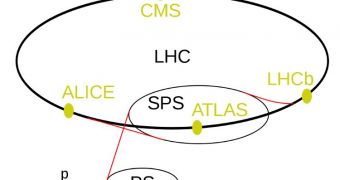Officials at the European Organization for Nuclear Research (CERN) say that the rumors making the rounds recently – that the Higgs boson has been finally identified by two particle detectors at the Large Hadron Collider – may not necessarily be true.
The two LHC detectors in question are the Compact Muon Solenoid (CMS) and A Toroidal LHC ApparatuS (ATLAS). Both may have discovered the Higgs at an energy level of 125 gigaelectronvolts (GeV), the rumors go.
Full results of their analysis are to be announced today, December 13, at a CERN conference. The ATLAS discovery has a certainty level of 3.5 sigma, while the CMS finding is rated at 2.5 sigma.
In scientific terms, a degree of certain of 5 sigma equals an established discovery, while 1 sigma represents the most uncertain results. This means that the new results are enough to provide an indication that the CERN team is on track, but definitely not a solid proof that the search is over.
What is very interesting about the new discovery is that it puts the Higgs boson in the middle of an energy range that has yet to be fully explored. Physicists know for a fact that the boson cannot exist in energy ranges lower than 114 GeV or higher than 141 Gev.
However, the 3,000+ physicists working at the LHC still have a massive volume of collision data to cover before they can make any kind of announcements regarding this particle. Discovering the Higgs would confirm the Standard Model of Particle Physics, Nature reports.
“We are moving forward in our understanding of the data and approval process but nothing will be solidly releasable for a while,” said the leader of the ATLAS experiment, physicist Bill Murray.
“These results will be based on the analysis of considerably more data than those presented at the Summer conferences, sufficient to make significant progress in the search for the Higgs boson, but not enough to make any conclusive statement on the existence or non-existence of the Higgs,” says Rolf Heuer.
The expert, who is also the director-general at CERN, adds that today's conference is unlikely to provide definite proof that the Higgs boson was identified and characterized. If the Higgs is proven to exist at 125 GeV, then the good news is that a physics theory called supersymmetry may also be valid.

 14 DAY TRIAL //
14 DAY TRIAL //